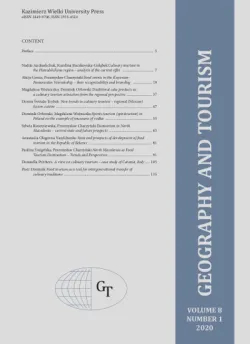Recreational use of an artificial water reservoir in case of the Piechcin Diving Base
DOI:
https://doi.org/10.34767/GAT.2021.09.05Słowa kluczowe:
qualified tourism, post-mining workings; sustainable development; diving; fuzzy logic; fuzzy aggregation normsAbstrakt
The paper aims to present divers’ opinions about the recreational use of the water reservoir in Piechcin with regards to four complex research areas. The study was conducted at the Diving Base in Piechcin located in the Żnin district, the Kuyavian-Pomeranian Voivodeship. The statistical data (divers’ opinions) were obtained employing a direct interview method via a questionnaire. The data were analysed with statistical methods, and the results were verified by applying fuzzy logic relations. The research shows that the owner has adapted and developed a post-mining excavation for divers, allowing for the safe practicing of qualified tourism. The technical and organizational conditions were assessed in two groups of respondents, namely those who expect some changes at the Base, and those who believe that further improvements are unnecessary.
Bibliografia
Bąbalska A., Musielińska R., Śliwińska-Wyrzychowska A., Bogdanowicz M., Witkowska E., 2014. The educational role of the „Lipówka” abandoned quarry in Rudniki near Częstochowa. Prace Komisji Krajobrazu Kulturowego 26 , 57-56 [In Polish with English abstract ].
Cichowska J.B., 2019. Assessment of the operation of the Piechcin Diving Centre (Piechcin Base) in the opinion of respondents. Polish Hyperbaric Research 4(69), 97-110.
Cichowska J., Garbacz J.K., Ciechalski J., 2018. The role of the Piechcin Centre in the development of specialised tourism with a view to diver preparation for penetration of the Baltic Sea. Polish Hyperbaric Research 2(63), 51-61.
Edwards J.A., Llurdes J.C., 1996. Mines and quarries: Industrial Heritage Tourism. Annals of Tourism Research 23(2), 341-363.
Jawecki B., 2012. Mines in the Landscape of Strzelin County – Selected Examples of Land-Use after Mineral Excavation Areas. Architektura Krajobrazu 4(37), 24–34 [In Polish with English abstract].
Jawecki B., 2017. The visual evaluation of the role of working granite quarries in the landscape of Strzelin County. Prace Komisji Krajobrazu Kulturowego 36, 79-97 [In Polish with English abstract].
Jawecki B., Tokarczyk-Dorociak K., Pawęska K., Malczewska B., Bawiec A., Ochman D., 2014. Directions for the reclamation and development of selected quarries in Strzelin county. [In:] Ochman D., Podoliński T., Jawecki B. (Eds.), Environment protection in industrial areas. Wydawnictwo Państwowej Wyższej Szkoły Zawodowej im. Witelona w Legnicy, Legnica, 59-72.
Jawecki B., Lorenc M.W., Tokarczyk-Dorociak K., 2015. Quarries in landscape of Strzelin County – native rock materials in local architecture. Zeitschrift der Deutschen Gesellschaft für Geowissenschaften 166(2), 205-225.
Kacprzak M., Bruchal M., 2011. Exploatation of the Limestone and Reclamation of the Post-Mining Areas on the Example of the Górażdże Limestone Mine. Inżynieria i Ochrona Środowiska 14(1), 49-58 [In Polish with English abstract].
Kondracki J., 1988. Geografia fizyczna Polski. Państwowe Wydawnictwo Naukowe, Warszawa [In Polish].
Majgier L., Badera J., Rahmonov O., 2010. Quarries in the Silesia Voivodship as touristic-recreational objects on industrial areas. Problemy Ekologii Krajobrazu 27, 267-275 [In Polish with English abstract].
Mamdani E.H., Assilian S., 1975. An experiment in linguistic synthesis with a fuzzy logic controller. International Journal of Man-Machine Studies 7(1), 1-13.
Mreła A., Sokolov O., Urbaniak W., 2019. The method of learning outcomes assessment based on fuzzy relations. Bulletin of the Polish Academy of Sciences, Technical Sciences 67(3), 527-533.
Nita J., 2010. Quarries in landscape and geoturism. Prace Komisji Krajobrazu Kulturowego 14, 243-251 [In Polish with English abstract].
Paulo A., 2008. Natural constraints of choosing determined directions of post-mining development. Gospodarka Surowcami Mineralnymi 24 (2/3), 9-40 [In Polish with English abstract].
Pietrzyk-Sokulska E., 2010. Water reservoirs in post-mining quarries – new component of cities landscape attractiveness. Prace Komisji Krajobrazu Kulturowego 14, 264-272 [In Polish with English abstract].
Pietrzyk-Sokulska E., 2015. Water reservoirs in quarries as a new element of landscape. Przegląd Geologiczny 63(8) , 464-469 [In Polish with English abstract].
Rogowska D., 2011. The use of fuzzy logic in inventory management. Logistyka 5, 1240-1247 [In Polish with English abstract].
Rutkowski L., 2012. Metody i techniki sztucznej inteligencji. Polskie Wydawnictwo Naukowe, Warszawa, pp. 452 [In Polish].
Sobala M., Pukowiec K., 2014. State of development of disused quarries in the Beskid Śląski and Żywiecki area and municipalities spatial policy. Prace Komisji Krajobrazu Kulturowego 26, 127-138 [In Polish with English abstract].
Sokolov O., Osińska, W., Mreła A., Duch W., 2018. Modeling of Scientific Publications Disciplinary Collocation Based on Optimistic Fuzzy Aggregation Norms. [In:] Świątek J., Borzemski L., Wilmowska Z. [Eds.], Information Systems Architecture and Technology: Proceedings of 39th International Conference on Information Systems Architecture and Technology – ISAT 2018 Part II. International Conference on Information Systems Architecture and Technology 853, 145-156.
Sołoma L., 2002. Metody i techniki badań socjologicznych. Wybrane zagadnienia. Wydawnictwo Uniwersytetu Warmińsko-Mazurskiego, Olsztyn, pp. 209 [In Polish].
Studium uwarunkowań i kierunków zagospodarowania przestrzennego gminy Barcin 2018 (tekst Studium-część pierwsza), 2018. Uwarunkowania zagospodarowania przestrzennego. Burmistrz Barcina, 1-82 [In Polish].
Zadeh L., 1965. Fuzzy sets. Information and Control 8(3), 338-353.
Zawadzki D., 2013. Use of flooded quarries and pit lakes in skilled tourism – SCUBA diving. [In:] Borówka R.K., Cedro A., Kavetstyy I. [Ed.], Recent problems of Geography. Wybrane problemy geografii turyzmu. Wydawnictwo Naukowe Uniwersytetu Szczecińskiego, 255-267 [In Polish with English abstract].

